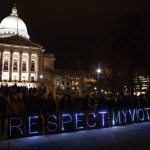Wearing green the right way for Earth Day
What exactly is sustainable clothing? The best way to be eco-friendly is to plant a tree, buy pre-owned clothes, & support charities for Earth Day in Milwaukee.
Earth Day is coming up, so you’ll probably be seeing a push from all things crunchy until around Monday of next week. Your two leather shoe-wearing vegan friends will assuredly be bothering you to join them for their yearly bout of trash picking, and the celebrities you follow on Twitter will be broadcasting one-liners about saving the environment to keep up appearances.
If you want to outdo all your cause-hungry acquaintances this year, you could preach the merits of eco-friendly clothing, or even easier, just wear it year-round anyway. However, sometimes it can be hard to tell if a brand is actually helping to improve apparel industry practices or hopping on the eco-bandwagon. How can you tell who’s being sincere these days?
The biggest complication with major brands marketing themselves as “sustainable” is the same necessary evil inherent in any corporation: they’re only about generating a profit. The larger a company is, to me, the more questionable their claims of fair practices and sustainability are. The only gauge of how  “natural” a garment is that the clothing industry has at the moment is a new, constantly-evolving assessment nobody wants to read that was introduced in July 2012 (the Higg Index) run by the self-supported and self-initiated Sustainable Apparel Coalition, a group formed in 2010.
“natural” a garment is that the clothing industry has at the moment is a new, constantly-evolving assessment nobody wants to read that was introduced in July 2012 (the Higg Index) run by the self-supported and self-initiated Sustainable Apparel Coalition, a group formed in 2010.
Some of SAC’s members include Adidas, Coca-Cola, DuPont, Gap, H&M, Nike, and Wal-Mart, which clearly makes me question the means the group uses to acquire members. The Environmental Protection Agency is a member as well, and SAC does genuinely include some reputable, award-winning companies such as our Menomonee Falls-based Kohl’s Department Stores. Unfortunately, the group is so new and vague about their rules that it isn’t quite convincing enough to me as an environmental authority in the apparel industry. There are exceptions to everything, and many of the variables that determine whether or not a garment is ‘green’ are next to impossible to measure.
For example, it’s pretty hard to run any product-based business without shipping items via gas-powered transportation or using synthetic packing and shipping materials. There’s also the issue of  where fabric may have originally come from, since bulk yardage is often made overseas where fair-labor practices are a bit of a grey area. The threads that make up our clothes are often refined using chemical bleaches or dyes, and recycled fabrics can contain bits of synthetic fibers too. Natural fibers could have been treated with pesticides or grown from genetically modified seeds from the get-go. Germophobes: are you scared yet?
where fabric may have originally come from, since bulk yardage is often made overseas where fair-labor practices are a bit of a grey area. The threads that make up our clothes are often refined using chemical bleaches or dyes, and recycled fabrics can contain bits of synthetic fibers too. Natural fibers could have been treated with pesticides or grown from genetically modified seeds from the get-go. Germophobes: are you scared yet?
All this nit-picking really only applies to the sustainability purists/elitists out there. For the rest of us, it’s probably wise to come to terms with the fact that there is basically no such thing as “eco-friendly” fashion. It’s just a made-up campaign to convince consumers to buy hemp tee shirts and Cotton® yoga pants. Any type of manufacturing uses resources and produces waste, so it’s just best not to whine about it and be smart about what you purchase.
The best way to at least pretend you’re being green is to buy used. It’s not causing any new  manufacturing to happen, lessens waste, and is therefore the most guilt-free option. It’s also light on the pocketbook. There are a ridiculous amount of charitable organizations (Goodwill, St. Vincent de Paul, The Salvation Army, American Council of the Blind, etc.) that sell used garments and goods, and most of them are probably within a 10-minute drive from wherever you live. Celebrate Earth Day by not buying anything, but when you’re ready to, buy local, buy pre-owned.
manufacturing to happen, lessens waste, and is therefore the most guilt-free option. It’s also light on the pocketbook. There are a ridiculous amount of charitable organizations (Goodwill, St. Vincent de Paul, The Salvation Army, American Council of the Blind, etc.) that sell used garments and goods, and most of them are probably within a 10-minute drive from wherever you live. Celebrate Earth Day by not buying anything, but when you’re ready to, buy local, buy pre-owned.






















A very interesting post.